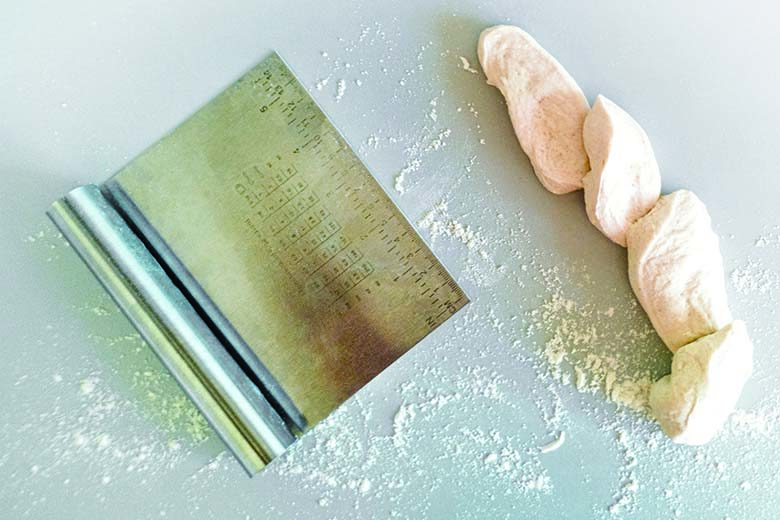
In its simplest form, a bench scraper is a wide rectangular piece of material with a handle along one edge and a straight or beveled edge on the other. Most people think of a bench scraper, also known as a bench cutter and pastry or dough scraper, as an ideal tool for cutting dough into portions or transferring delicate pastries onto baking sheets. While that’s true, it also can be used to cut casseroles and cold butter or to scrape sticky dough bits off the kitchen counter. Like a bench scraper, the versatile bowl scraper is a multifunctional kitchen tool. It is generally made of hard plastic or rubber with one flat side and one rounded end.
Bench Scraper Over Knife Blade
There is a rule that home cooks may not know: Never use the blade of a knife to transfer food from a cutting board. The blade can become dull or damaged, ruining the sharp edge that makes it efficient and safe to use. In comparison, bench scrapers have a blunt edge that is ideal for scraping. Most bench scrapers are the size of a small notebook, with a large surface area — much bigger than a knife blade. The larger surface area makes it easy to scoop sizable quantities of sliced or diced ingredients, such as onions or fresh herbs, from the cutting board. It also is a great tool for mashing garlic and creating a paste.
Style, Comfort and Efficiency
The most efficient bench scrapers are made of steel or hard, durable plastic with a beveled edge — not those made of rubber. Steel and plastic versions are durable, proficient in cutting and resistant to bending. Plastic scrapers have the added benefit of not scratching a wooden, granite or marble surface when cutting through foods such as rolled pastas or various doughs. Rubber scrapers can bend to the shape of a bowl, making them great for scraping and cleaning inside mixing bowls. The flexibility of rubber scrapers makes it easy to push purees through fine mesh strainers when making soups, sauces and mousselines.
The handle of the bench scraper can improve the efficiency of tasks. If the handle is formed with the surface area and lies flat along the same side, like most stainless-steel models do, scooping up chopped herbs or diced onions is a breeze.
Rubber and wood handles are more comfortable than stainless steel. Thin polypropylene handles may be the best of both worlds, offering a thin handle that still allows the scraper to lie flat for more comfortable use.
Consistency, Improved
Some bench scrapers have a ruler along the bottom edge to help make consistent cuts and portions. Even without the ruler feature, using a bench scraper to shape sticky doughs such as brioche can help create evenly sized dough balls that can be weighed for accuracy and consistency.
Easy Cleanup
The ease and convenience of a bench scraper makes it not only one of the most versatile kitchen tools, but also one with very low maintenance. One of the biggest benefits is easy cleanup, especially when flour or dough particles stick to the counter. When cleaning with a bench scraper, use warm water to release large bits of food as you scrape the prep surface. Follow with hot, soapy water to thoroughly clean the utensils and countertop. To clean the bench scraper itself, toss in the dishwasher or clean by hand using hot, soapy water.
References
Chin T. Every kitchen should have a bowl scraper. Serious Eats website. https://www.seriouseats.com/bowl-scraper. Updated May 28, 2020. Accessed May 25, 2021.
Christensen E. Handy Kitchen Tool: The Bench Scraper. Kitchn website. https://www.thekitchn.com/handy-kitchen-tool-the-bench-s-45469. Published March 17, 2008. Accessed May 25, 2021.
Crowley H. 5 Kitchen Tools that make meal prep easier. America’s Test Kitchen website. https://www.americastestkitchen.com/articles/2129-5-kitchen-tools-that-make-meal-prep-easier. Published January 27, 2020. Accessed May 25, 2021.
Eby M. How to clean up dough. Food & Wine website. https://www.foodandwine.com/cooking-techniques/baking/how-to-clean-up-dough-after-baking. Published May 28, 2020. Accessed May 25, 2021.
Foster K. Why a bench scraper is a chef knife’s best sidekick. Kitchn website. https://www.thekitchn.com/why-a-bench-scraper-is-a-chefs-knifes-best-sidekick-234674. Published May 1, 20219. Accessed May 25, 2021.
Harlan J. What is a Bench Scraper? The Spruce Eats website. https://www.thespruceeats.com/definition-bench-scraper-908878#:~:text=Most%20bench%20scrapers%20are%20made,over%20the%20stainless%20steel%20kind. Updated December 24, 2020. Accessed May 25, 2021.
McManus L. Testing Bench Scrapers. Cooks Illustrated website. https://www.cooksillustrated.com/articles/1396-testing-bench-scrapers. Published March 1, 2014. Accessed May 25, 2021.
Tamarkin D. The best bench scrapers for smashing, cutting, collecting, cleaning, and basically every other kitchen task. Epicurious website. https://www.epicurious.com/expert-advice/best-bench-scrapers-article. Published September 13, 2017. Accessed May 25, 2021.







